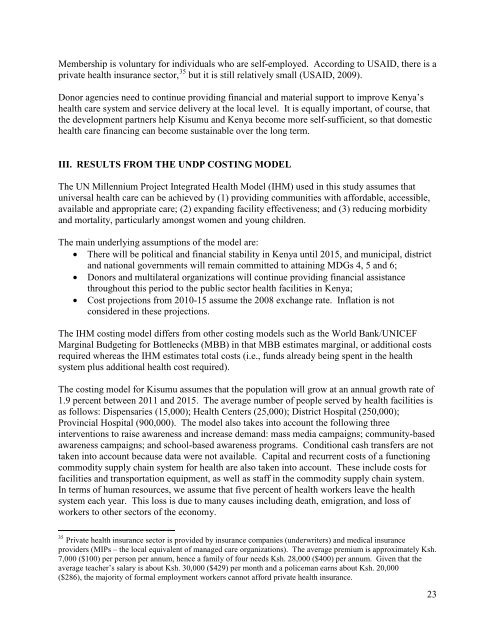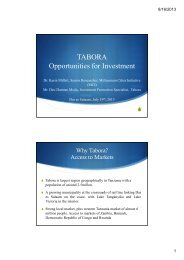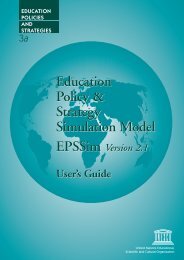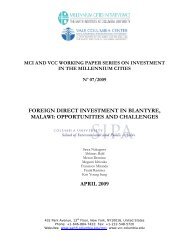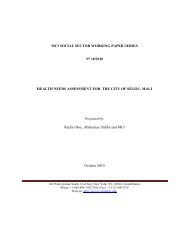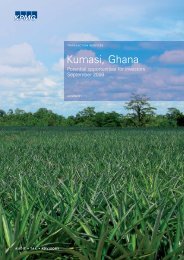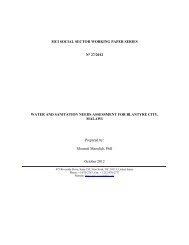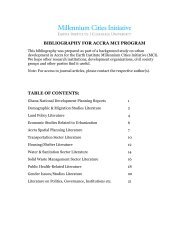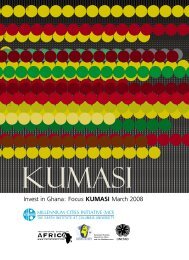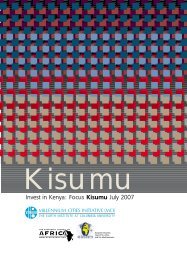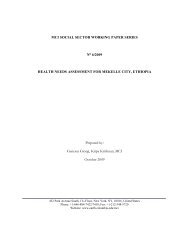Health Needs Assessment for Kisumu, Kenya - Millennium Cities ...
Health Needs Assessment for Kisumu, Kenya - Millennium Cities ...
Health Needs Assessment for Kisumu, Kenya - Millennium Cities ...
You also want an ePaper? Increase the reach of your titles
YUMPU automatically turns print PDFs into web optimized ePapers that Google loves.
Membership is voluntary <strong>for</strong> individuals who are self-employed. According to USAID, there is a<br />
private health insurance sector, 35<br />
but it is still relatively small (USAID, 2009).<br />
Donor agencies need to continue providing financial and material support to improve <strong>Kenya</strong>’s<br />
health care system and service delivery at the local level. It is equally important, of course, that<br />
the development partners help <strong>Kisumu</strong> and <strong>Kenya</strong> become more self-sufficient, so that domestic<br />
health care financing can become sustainable over the long term.<br />
III. RESULTS FROM THE UNDP COSTING MODEL<br />
The UN <strong>Millennium</strong> Project Integrated <strong>Health</strong> Model (IHM) used in this study assumes that<br />
universal health care can be achieved by (1) providing communities with af<strong>for</strong>dable, accessible,<br />
available and appropriate care; (2) expanding facility effectiveness; and (3) reducing morbidity<br />
and mortality, particularly amongst women and young children.<br />
The main underlying assumptions of the model are:<br />
• There will be political and financial stability in <strong>Kenya</strong> until 2015, and municipal, district<br />
and national governments will remain committed to attaining MDGs 4, 5 and 6;<br />
• Donors and multilateral organizations will continue providing financial assistance<br />
throughout this period to the public sector health facilities in <strong>Kenya</strong>;<br />
• Cost projections from 2010-15 assume the 2008 exchange rate. Inflation is not<br />
considered in these projections.<br />
The IHM costing model differs from other costing models such as the World Bank/UNICEF<br />
Marginal Budgeting <strong>for</strong> Bottlenecks (MBB) in that MBB estimates marginal, or additional costs<br />
required whereas the IHM estimates total costs (i.e., funds already being spent in the health<br />
system plus additional health cost required).<br />
The costing model <strong>for</strong> <strong>Kisumu</strong> assumes that the population will grow at an annual growth rate of<br />
1.9 percent between 2011 and 2015. The average number of people served by health facilities is<br />
as follows: Dispensaries (15,000); <strong>Health</strong> Centers (25,000); District Hospital (250,000);<br />
Provincial Hospital (900,000). The model also takes into account the following three<br />
interventions to raise awareness and increase demand: mass media campaigns; community-based<br />
awareness campaigns; and school-based awareness programs. Conditional cash transfers are not<br />
taken into account because data were not available. Capital and recurrent costs of a functioning<br />
commodity supply chain system <strong>for</strong> health are also taken into account. These include costs <strong>for</strong><br />
facilities and transportation equipment, as well as staff in the commodity supply chain system.<br />
In terms of human resources, we assume that five percent of health workers leave the health<br />
system each year. This loss is due to many causes including death, emigration, and loss of<br />
workers to other sectors of the economy.<br />
35 Private health insurance sector is provided by insurance companies (underwriters) and medical insurance<br />
providers (MIPs – the local equivalent of managed care organizations). The average premium is approximately Ksh.<br />
7,000 ($100) per person per annum, hence a family of four needs Ksh. 28,000 ($400) per annum. Given that the<br />
average teacher’s salary is about Ksh. 30,000 ($429) per month and a policeman earns about Ksh. 20,000<br />
($286), the majority of <strong>for</strong>mal employment workers cannot af<strong>for</strong>d private health insurance.<br />
23


